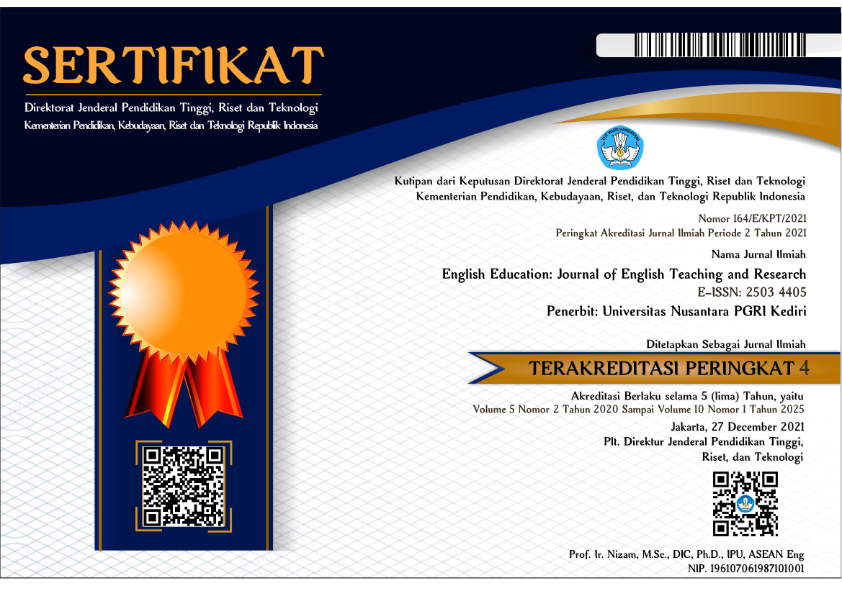Grammar Teaching and Learning in English Language Class: Students’ View
DOI:
https://doi.org/10.29407/jetar.v9i1.21536Keywords:
grammar teaching, explicit grammar teaching, implicit grammar teachingAbstract
Grammar, which differs in structure among languages, plays an important component of language acquisition. Grammar proficiency is essential for clear communication since it improves understanding and coherence. Therefore, mastering English grammar is essential to EFL study. This study explores the students’ view on the importance of grammar in language acquisition in detail and explores how EFL students evaluate the teaching and learning of grammar. A qualitative method was used, including open-ended questionnaire and interview, to better understand students' perspectives. The results support the participants' understanding of grammar's significance and reinforce the idea that grammar teaching is essential. The findings of this study further highlight the need of combining explicit and implicit teaching strategies within grammar teaching and learning, acknowledging the mutually beneficial nature of both methods. These strategies further emphasise the critical role that technology and the internet play in language learning. These results together offer educators knowledge for developing effective grammar teaching strategies that correspond with students' viewpoints and academic objectives.
Downloads
References
Chen, Y., & Hoshower, L. B. (2003). Student Evaluation of Teaching Effectiveness: An assessment of student perception and motivation. Assessment & Evaluation in Higher Education, 28(1), 71–88. https://doi.org/10.1080/02602930301683
Ellis, R. (2006). Current issues in the teaching of grammar: An SLA perspective. TESOL Quarterly, 40(1), 83–106.
Komara, C., & Tiarsiwi, F. (2021). Exploring Indonesian EFL Learners’ Perception of English Learning Grammar. Journal of English Language Teaching and Linguistics, 6(2), 459. https://doi.org/10.21462/jeltl.v6i2.564
Krashen, S. (1982). Principles and practice in second language acquisition. Pergamon.
Moleong, L. J. (2010). Metodologi Penelitian Kualitatif. PT Remaja Rosda karya.
Nazari, N. (2013). The Effect of Implicit and Explicit Grammar Instruction on Learners’ Achievements in Receptive and Productive Modes. Procedia - Social and Behavioral Sciences, 70, 156–162. https://doi.org/10.1016/j.sbspro.2013.01.051
Thornburry, S. (1999). How to Teach Grammar. Longman.
Wangchuk, N., Wangchuk, C., Sharma, D., & Dorji, P. (2021). Perception and Practices of Teaching Grammar in Higher Secondary Schools in Bhutan. Journal of English as A Foreign Language Teaching and Research, 1(1), 46–60. https://doi.org/10.31098/jefltr.v1i1.453
White, L. (1987). Against Comprehensible Input: the Input Hypothesis and the Development of Second-language Competence. Applied Linguistics, 8(2), 95–110. https://doi.org/10.1093/applin/8.2.95
Widodo, H. (2006). Approaches and procedures for teaching grammar. English Teaching: Practice and Critique, 5(1), 122–141.
Zhang, J. (2009). Necessity of Grammar Teaching. International Education Studies, 2(2). https://doi.org/10.5539/ies.v2n2p184
ZHENG Ling. (2015). Explicit Grammar and Implicit Grammar Teaching for English Major Students in University. Sino-US English Teaching, 12(8). https://doi.org/10.17265/1539-8072/2015.08.002
Downloads
Published
Issue
Section
License
Authors who publish with this journal agree to the following terms:
- Copyright on any article is retained by the author(s).
- The author grants the journal, the right of first publication with the work simultaneously licensed under a Creative Commons Attribution License that allows others to share the work with an acknowledgment of the work’s authorship and initial publication in this journal.
- Authors are able to enter into separate, additional contractual arrangements for the non-exclusive distribution of the journal’s published version of the work (e.g., post it to an institutional repository or publish it in a book), with an acknowledgment of its initial publication in this journal.
- Authors are permitted and encouraged to post their work online (e.g., in institutional repositories or on their website) prior to and during the submission process, as it can lead to productive exchanges, as well as earlier and greater citation of published work.
- The article and any associated published material is distributed under the Creative Commons Attribution-ShareAlike 4.0 International License








 Article template
Article template



